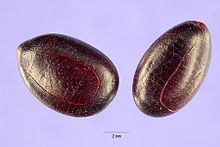| Anonychium | |
|---|---|

| |
| Prosopis africana seeds | |
| Conservation status | |
 Least Concern (IUCN 3.1) | |
| Scientific classification | |
| Kingdom: | Plantae |
| Clade: | Tracheophytes |
| Clade: | Angiosperms |
| Clade: | Eudicots |
| Clade: | Rosids |
| Order: | Fabales |
| Family: | Fabaceae |
| Genus: | Anonychium Schweinf. (1868) |
| Species: | A. africana |
| Binomial name | |
| Anonychium africana (Guill. & Perr.) C.E.Hughes & G.P.Lewis (2022) | |
| Synonyms | |
| |
Anonychium is a genus of plant in the pea family (Fabaceae). It includes a single species, Anonychium africanum, a tree native to northern Sub-saharan Africa from Mauritania to Uganda and to Saudi Arabia. It is known by the synonym Prosopis africana, and its common names include African mesquite, iron tree, gele (in Malinke), okpehe, and somb tree. Okpehe is the name given by the Idoma and Igala people of Nigeria to both the tree and its fermented seeds. All of the other derivatives such as okpeye and okpiye stem from the noun okpehe used by the Idoma and Igala people of present day Benue State of Nigeria.
In the Serer creation myth, it is one of the sacred trees that grew not just first, but also within the primordial swamp on Earth.
Logs harvested from mature trees are one of the hardwoods used in crafting the shells of traditional djembes. Seeds of P. africana are used in Nigeria to prepare daddawa, kpaye, and okpeye, which are fermented products used as food condiments.
Several species of bacteria especially Bacillus subtilis, Bacillus licheniformis, Bacillus megaterium, Staphylococcus epidermidis and Micrococcus spp. were found to be the most actively involved organisms in the production of okpiye. Sequencing of 16S rRNA genes of selected strains representative of the major clusters revealed that the Bacillus strains associated with okpehe fermentation were B. subtilis, B. amyloliquefaciens, B. cereus and B. licheniformis (in decreasing order of incidence). The presence of enterotoxin genes in all B. cereus strains was demonstrated by multiplex PCR. The high incidence of detection (20%) of possibly pathogenic B. cereus strains that contained enterotoxin genes indicated that these fermented foods may constitute a potential health risk.
The seeds also produce a gum.
The plant produces the alkaloids prosopine and prosopinine.
References
- Botanic Gardens Conservation International (BGCI).; IUCN SSC Global Tree Specialist Group. (2019). "Prosopis africana". IUCN Red List of Threatened Species. 2019: e.T62027748A148988867. doi:10.2305/IUCN.UK.2019-2.RLTS.T62027748A148988867.en. Retrieved 4 October 2021.
- ^ Anonychium africanum (Guill. & Perr.) C.E.Hughes & G.P.Lewis. Plants of the World Online. Retrieved 11 August 2023.
- Barminas, J.T.; Maina, H.M.; Ali, J. (1998). "Nutrient content of Prosopis africana seeds". Plant Foods for Human Nutrition. 52 (4): 325–328. doi:10.1023/A:1008045218320. PMID 10426119. S2CID 20427894.
- Omafuvbe, B.O; Abiose, S.H; Adaraloye, O.O (1999). "The production of 'Kpaye' – a fermented condiment from Prosopis africana (Guill and Perr) Taub. Seeds". International Journal of Food Microbiology. 51 (2–3): 183–186. doi:10.1016/S0168-1605(99)00088-4. PMID 10574093.
- Obeta, J.A.N.; Ugwuanyi, M.A.A (1996). "Microbiology of the production of okpeye, a condiment from seeds of Prosopis africana Taub". Tropical Science. 36 (48): 206–210.
- Achi, O. K. (1992). "Microorganisms associated with natural fermentation of Prosopis africana seeds for the production of okpiye". Plant Foods for Human Nutrition. 42 (4): 297–304. doi:10.1007/BF02194090. PMID 1438073. S2CID 42709829.
- Oguntoyinbo, FA; Huch, M; Cho, GS; Schillinger, U; Holzapfel, WH; Sanni, AI; Franz, CM (2010). "Diversity of bacillus species isolated from okpehe, a traditional fermented soup condiment from Nigeria". Journal of Food Protection. 73 (5): 870–878. doi:10.4315/0362-028X-73.5.870. PMID 20501038.
- Adikwu, MU; Ezeabasili, SI; Esimone, CO (2001). "Evaluation of the physico-chemical properties of a new polysaccharide gum from Prosopis africana". Bollettino Chimico Farmaceutico. 140 (1): 40–45. PMID 11338777.
- Ratle, G; Monseur, X; Das, BC; Yassi, J; Khuong-Huu, Q; Goutarel, R (1966). "Prosopine and prosopinine alkaloids of Prosopis africana (Guill and Perr) Taub. (Preliminary note)". Bulletin de la Société Chimique de France (in French). 9: 2945–2947. PMID 5992092.
External links
 Media related to Prosopis africana at Wikimedia Commons
Media related to Prosopis africana at Wikimedia Commons
| Taxon identifiers | |
|---|---|
| Anonychium | |
| Anonychium africanum | |
| Prosopis africana |
|
| Coulteria africana | |